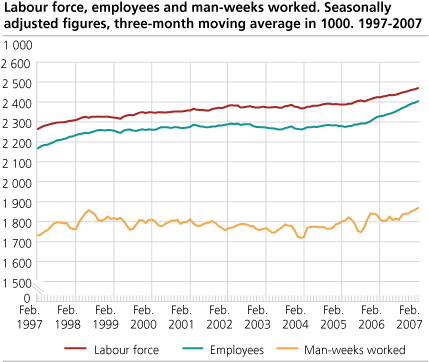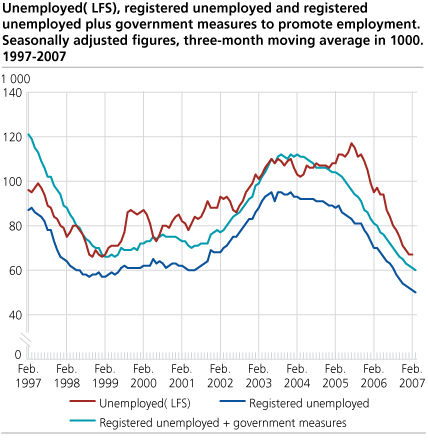Content
Published:
This is an archived release.
More elderly people employed
The proportion of persons aged 67-74 years and 55-66 years in the labour force rose by 4 and 1.5 percentage points respectively from the first quarter of 2006 to the first quarter of 2007, according to new figures from the Labour Force Survey (LFS). For the working-age population (aged 15-74), the growth was 0.3 percentage points.
Seasonally adjusted figures: The growth in employment continuesAdjusted for seasonal variations, employment increased from the fourth quarter of 2006 to the first quarter of 2007, while the unemployment rate remained at the same level. Adjustments for seasonal variations allow for the analysis of current developments in the labour market, and serve as an alternative to comparisons with the corresponding quarter in the previous year. Seasonally adjusted figures are presented in a separate article . |
The labour force (the sum of employment and unemployment) increased by 42 000 people. This equals the growth in the working-age population from the first quarter of 2006 to the first quarter of 2007. The proportion of persons aged 67-74 years in the labour force increased from 6.9 to 10.9 per cent. The growth was due to an increase in the number of persons who combine short part-time jobs (below 20 hours per week) with old age pension. Labour force participation rose by 0.8 percentage points for women, while there was no change for men.
Equal growth in full-time and part-time
The relative growth in full-time and part-time employment was slightly more than 3 per cent for both categories from the first quarter of 2006 to the first quarter of 2007. Average settled working hours remained stable at 34 hours per week. Average settled weekly working hours for men were 37.1 hours, compared to 30.5 hours for women.
Strongest growth in construction and financial intermediation
The total growth in employment was 71 000, and the relative growth was strongest in construction with an increase of 10.6 per cent, corresponding to 17 000 people. Also financial intermediation and other business activities had a strong growth with a growth in employment of 20 000 people. This corresponds to a 9.1 per cent increase.
Nearly 70 per cent of the employment growth was in Oslo and Akershus counties (with an increase of 25 000) and in the four counties of Western Norway (with an increase of 24 000). The six counties account for half of all employment in Norway.
The number of employees with temporary contracts down by 17 000
193 000 were on temporary contracts in the first quarter of 2007, a reduction of 17 000 from the first quarter of 2006. 8.8 per cent of all employees were on temporary contracts, down by one percentage point from the first quarter of 2006. Health and social work had a reduction in the proportion of employees on temporary contracts, but is still on a high level with 13.7 per cent. Education had the highest share of employees on temporary contracts (15.7 per cent of all employees). Manufacturing (4 per cent) and transport and communication (5.5 per cent) had the lowest proportion of temporary employees.
Unemployment fell by 28 000
According to the LFS, the number of unemployed fell by 28 000 from the first quarter of 2006 to the first quarter of 2007. The decline were mainly for the age group 25-54 years, where unemployment fell by 25 000. The unemployment rate stood at 2.7 per cent; the male unemployment rate was 2.7 per cent, the female was 2.6 per cent. The number of registered unemployed with the Labour and Welfare Organisation showed a decline of 20 000 over the same period.
The proportion of long-term unemployed - defined as persons who have been unemployed for at least six consecutive months - was 25 per cent in the first quarter of 2007, down 8 percentage points from the first quarter of 2006. The reduction in the share of long-term unemployment has been among people unemployed for more than a year.
The number of underemployed unchanged
Underemployment is defined as employees with part-time as settled working hours who want to work more hours. The number of underemployed was 116 000 in the first quarter of 2007, unchanged from the first quarter of 2006. In the first quarter of 2007 the underemployed represent 17.5 per cent of all part-time employees.
When accounting for the fact that many unemployed and most underemployed are looking for less than full-time work, these two groups together wanted work equivalent to a total of 91 000 full-time positions in the first quarter of 2007 - 30 000 less than in the first quarter of 2006.
(1) The figures for underemployment in 2006 and 2007 are incorrect. More information is available here .
Tables:
- Table 1. Population aged 15-74(1) in the labour force, man-weeks worked, unemployed (LFS)(2), registered unemployed persons and persons employed by government measures (Aetat). 1 000 and per cent
- Table 2. Population aged 16-74(1) år in the labour force, employed persons and unemployed persons by sex (LFS)(2). 1 000 and per cent
- Table 3. Persons in the labour force and employed persons by age and sex (LFS). 1 000 and per cent.
- Table 4. Population aged 15-74, employed persons by settled/usual working hours per week(1) and unemployed persons by age and sex (LFS). 1 000
- Table 5. Persons in the labour force aged 15-74 by age and sex. 1 000 and as per cent of all in each group
- Table 6. Employed persons by sex and settled/usual working hours pr week (LFS).1 000.
- Table 7. Population aged 16-74 by main activity, part-time employment1 and age (LFS). 1 000.
- Table 8. Employed persons aged 15-74 by major industry division (LFS). 1 000
- Table 9. Number of man-hours worked per week1 by industry division (LFS).1 000.
- Table 10. Employed persons,total, and employed persons at work by status and sex. Number of man-weeks worked1 and actual working hours per week (LFS).
- Table 11. Employed persons aged 15-74 and absence from work(1) during the whole reference week by reason for absence and sex (LFS). 1 000 and per cent
- Table 12. Employees aged 15-74 with temporary jobs, by major industry division (LFS). 1 000 and as per cent of all employees
- Table 13. Unemployed persons aged 15-74 by sex and age (LFS). 1 000 and per cent
- Table 14. Unemployed persons aged 15-74 by duration of job search (LFS). 1 000 and per cent
- Table 15. Unemployed persons by main activity (LFS). 1 000.
- Table 16. Unemployed and underemployed persons aged 15-74, by sex and desired working hours per week. Number of man-weeks (of 37,5 hours) supplied (LFS). 1000
- Table 18. Persons in the labour force by sex and region(LFS). 1 000 and in per cent of total.
- Table 19. Employed persons by sex and region (LFS).1 000.
- Table 20. Employed persons by sex and regions (LFS) as per cent of all inn each group.
- Table 21 Employed persons, by some major industry division and region (LFS). 1997-2006 . 1 000
Contact
-
Arbeidsmarked og lønn
E-mail: arbeidsmarked@ssb.no
-
Erik Herstad Horgen
E-mail: erik.horgen@ssb.no
tel.: (+47) 93 08 68 62
-
Håvard Hungnes Lien
E-mail: havard.lien@ssb.no
tel.: (+47) 40 90 26 06


